Our plan was to travel to Hoorn by train, and then catch the steam tram that ran between Hoorn and Medemblik. There was an option to then travel via passenger boat from Medemblik to Enkhuizen, but we preferred to make the return journey on the steam tram, and then give ourselves time to have a look around Hoorn. The tram is actually a train. Why tram you may ask. Well, in the Netherlands, a directive stated that any train travelling on a non-national line track was deemed to be a tram.
After a hastily devoured breakfast, we route marched to the station to catch a train down to Hoorn. We arrived in good time, and the train was there waiting for us. Then came the initiative test, obtaining tickets. There was no ticket office, just machines which would not accept any of our cards. The only resort was cash, in coins only! No sane person carried that amount of coins with them. In a moment of inspiration, Meryl dashed across to a nearby building which also served as a tourist office, and there she managed to buy train tickets. She sprinted back to join us like a Chinese whippet, frantically waving the tickets in her hand. Rounding a corner onto the platform, we saw our training quietly accelerating away in the distance. Rex and I cursed, me in English and Rex in fluent Dutch. My God he was getting really good now. We pondered what to do until the next train. It wasn't a disaster since we had built some margin into our journey so we would still be able to catch the steam tram out of Hoorn. Then, Rex noticed Meryl was nowhere to be seen. We scoured the station, tourist centre and canal side, but we could not find her for love nor money. Rex was understandably getting quite concerned. I heard Rex muttering, the words "Nelson", "never" and "trouble" sprung to mind. The next train arrived, and now he was even more concerned. At last she was located sitting on a bench right down the platform. Rex's blood pressure started to drop.
We sat on the top deck of the double-decker train, and shortly an English couple passed by us. The chap had one of those rather loud voices that wanted itself to be heard, whether the world wanted to listen to it or not. He had issue with the fact that on the continent, tickets had to be time and date stamped by a machine on the platform. "Why should I? The ticket is a valid receipt," he protested. "Get a life," I thought.
An attractive, charming Dutch lady overheard our English accents and gave us some advice on sights to see in Medemblik and Hoorn, but as she was doing so, a bunch of noisy children entered our carriage, so she moved across to sit opposite me. The woman enquired of our trip, and it transpired she was a keen sailor. She had sailed along the southern coast of England, and appeared to know the East Anglian coast quite well. I learned that she, as well as many Dutch people, had visited the Butt and Oyster at Pin mill on the River Orwell, close to where I live. As we passed through a suburb of Hoorn, she explained it was an undesirable area of town where people were surviving on the bread line. All countries have such areas I guess. She told us how the Netherlands were starting to feel the economic pinch, and despite the country's apparent wealth, it would soon have to start tightening its belt as most other European countries have had to do. She worked in health provision was already being felt in that sector. She hinted that "spongers" would need to be brought back to the work place to begin the return to recovery.
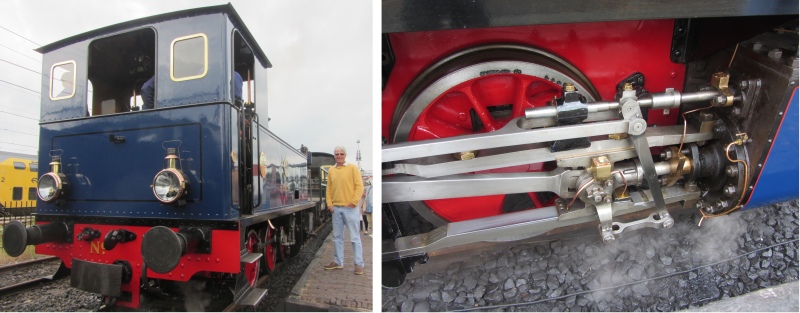 Steam Tram at Hoorn |
About ten or so old carriages were hooked up to this steam tram, some of which contained parties of excited Japanese tourists. These groups oscillated between carriages and platform, performing the ritual of taking snapshots of each other in every conceivable combination, dragging in station staff as props.
Constructed in 1887, the Hoorn-Medemblik line connects two proud and historic seaport cities in West Friesland. During the Dutch Golden age in the 1600s, Hoorn and Medemblik were launching pads for the deep-bottomed sailing vessels which made the Netherlands a power in trade and exploration (indeed, South America's Cape Horn honours the city of Hoorn, so named by the Dutch explorers who first reconnoitred the area). By the 1900s, however, silting in the Zuider Zee, Holland's great inland sea, had caused the overseas trade to desert both cities in favour of the North Sea port of Rotterdam. By the time the railway came to link the two towns, the area was more a rural backwater than a centre of commerce. Despite the region's reduced circumstances, the rail line did a good business for eighty years or so, ferrying fish from the two ports and fruits and grains from the nearby farms to the great urban markets at Amsterdam. However, declining traffic volumes placed the line on the closure list in the 1960s. The prospect of abandonment rallied the line's friends, and enthusiasts successfully took over operation of the railway in 1968.
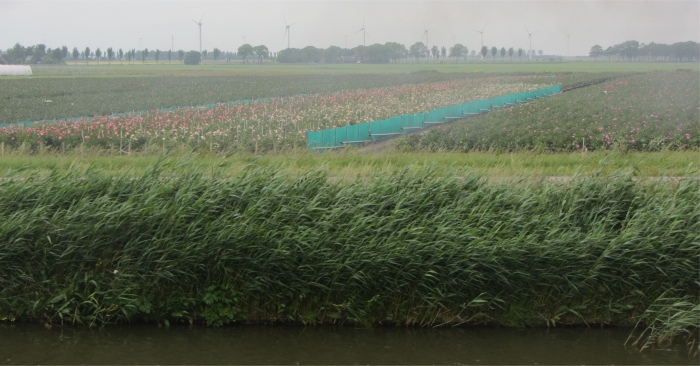 Passing the Flower Fields .... |
 .... and Passing a Polder Mill |
The tram stopped at Benningbroek for 15 minutes, a comfort break for some and a photo opportunity for others. The small station had nothing really to show for itself, apart from old signalling equipment, and a rather odd, old poster that featured eight Welsh women, all wearing shawls and the slightly tapering black crown hats found in Wales, advertising Welsh anthracite coal.
 Rex Sampling Poffertjes |
 Medemblik Stadhuis |
We did partake of some tasty morsels on our journey to Medemblik, a portion of poffertjes, a traditional Dutch batter treat. Resembling small, fluffy pancakes, they are made with yeast and buckwheat flour, and have a light, spongy texture. Typically, poffertjes are served with powdered sugar and butter, and sometimes syrup. We enjoyed this snack, in fact Meryl was in ecstasies.
We eventually ground, clanked and lurched into our destination, where we alighted into lashings of rain. As one Dutchman had put it recently, welcome to summer in Holland.
Medemblik was a prosperous trading town, when, in 1282, Floris V, Count of Holland, successfully invaded West Friesland. He built several fortresses to control the region, one of which was Kasteel Radboud in Medemblik, and awarded Medemblik city rights in 1289. After Floris V had been murdered in 1296, the local Frisian besieged the castle, but in 1297 an army from Holland thwarted their efforts to starve out the inhabitants, which included Medemblik citizens.
 Radboud Castle |
 Medemblik Revenge |
Medemblik obtained town walls in 1572, so that the castle lost its role as a refuge for the citizens, which led to its partially dismantling in 1578. Over the centuries the castle fell into decay, but in 1889 it became property of the crown and was restored to be used as a courthouse, which function it served until 1934. Anticipating the German invasion, the Rijksmuseum in September 1939 chose the castle as the initial hiding place of Rembrandt's "Night Watch".
We passed the large, imposing, old Stadhuis against the backdrop of the dike, and joined the happy throng walking in the rain down touristy Nieuwstraat, lined with many 17th and 18th century gables. We left them behind, hiding in gifts shops and restaurants, while we carried on to Kaasmarkt before crossing bridges over Oosterhaven and Pekelharinghaven, then taking a sharp left and following the harbour up to Oudevaartsgat. This conveniently took us past some public conveniences that were being cleaned; I was allowed to use the ladies toilet, Meryl was not permitted to use either! We rounded a corner and there it was, Radboud Castle with its moat.
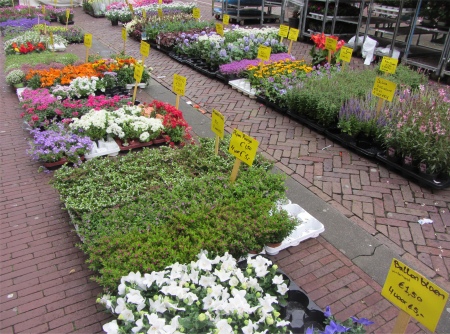 Part of a Flower Stall in Hoorn |
We only had 30 minutes spare to view the castle since we needed to return to the station promptly in order to catch the steam tram back to Hoorn. The 13th century castle housed a modest collection of objects illustrating the history of the building. There was also a permanent exhibition that provided insight into the daily life in the Middle Ages. Although much of the castle had been restored, it looked stunning from the outside; a very photogenic castle.
We just had time to walk to the adjacent Oosterdijk for a gaze over the Ijsselmeer before traipsing through the rain back to the station, together with dozens of other bedraggled weary travellers, and took refuge on the train. Our return to Hoorn was no different to our outward journey, save for our indulgence in two portions of poffertjes.
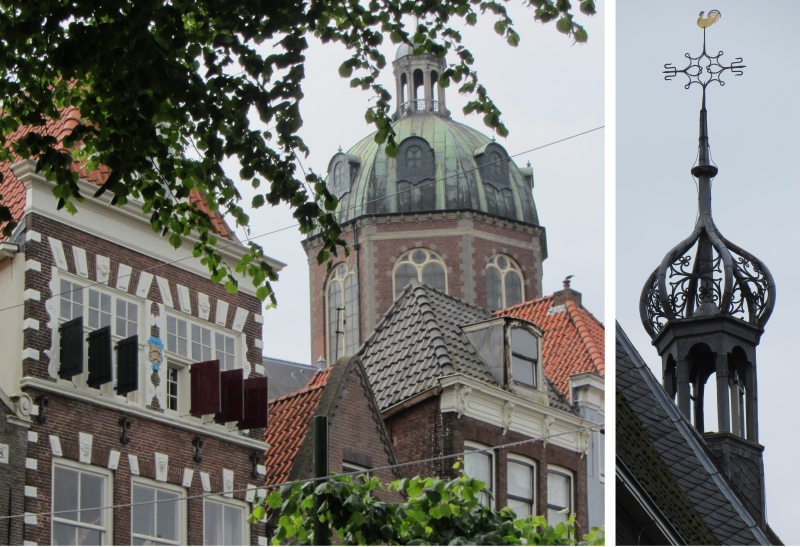 Interesting Hoorn Skylines |
Founded in 716, Hoorn rapidly grew to become a major harbour town. During Holland's "Golden Age", Hoorn was an important home base for the Dutch East India Company (VOC) and a very prosperous centre of trade. The Hoorn fleet plied the seven seas and returned laden with precious commodities. Exotic spices such as pepper, nutmeg, cloves, and mace were sold at vast profits. With their skill in trade and seafaring, sons of Hoorn established the town's name far and wide. Jan Pieterszoon Coen (1587-1629) is famous for his violent raids in Dutch Indies (now Indonesia), where he "founded" the city of Batavia in 1619 (now Jakarta). There is a big statue of Coen on the Rode Steen square in the centre of Hoorn. In 1616, the explorer Willem Corneliszoon Schouten braved furious storms as he rounded the southernmost tip of South America. He named it Kaap Hoorn (Cape Horn) in honour of his home town.
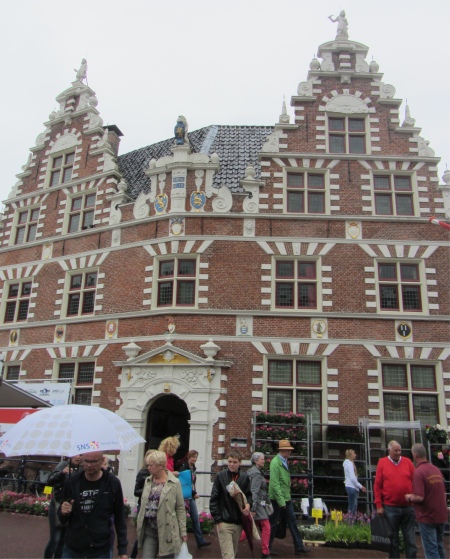 Hoorn Nieuwstraat and More Flowers |
The years after the Second World War saw a period of renewed growth. At the centre of a flourishing horticultural region, Hoorn developed an extremely varied economy, and was also regarded as a cheese centre. During the 1960s, Hoorn was designated an "overflow" city to relieve pressure on the overcrowded Randstad region. Thousands of people swapped their cramped little apartments in Amsterdam for a family house with garden in one of Hoorn's modern new developments.
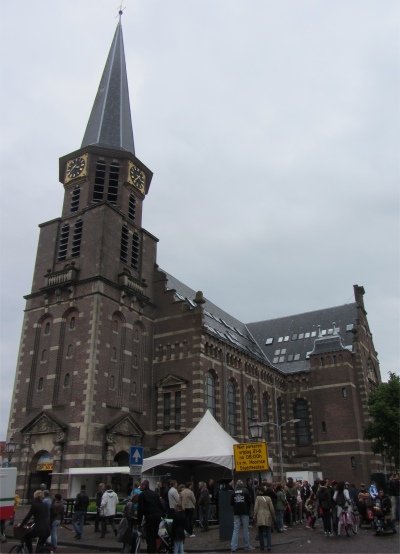 Grote Kerk, Inside Converted into Retail Spaces and Apartments |
We found our way down Nieuwstraat and past the Grote Kerk in the Kerkplein. This route brought us into the town square, Rode Steen, in which a large stage had been set up on which a very young band blasted out rock music. Perhaps they were singing in Dutch, but the distortion tore all lyrics apart. A statue of Jan Pieterszoon Coen stood in the square, and underneath it was a plaque that covered his exploits, but also raised controversy, stating "According to critics, Coen's violent mercantilism in the East Indian archipelago does not deserve to be honoured." Hidden behind all this razzmatazz, many beautiful, ornate, historic buildings stood, many with facades leaning out at crazy angles. Prosperity can still be seen in the historical town centre with its atmosphere of bygone eras. Listed buildings are an integral part of everyday life, providing space for shops, offices, museums and homes.
We partook in a coffee in the main square, giving our eardrums a sound drumming in the process, and with ears ringing we headed down a narrow alley, the Grote Havensteeg. This brought us in to the historic harbour area, where we walked around the Appelhaven, passing many fine old warehouses, many having different port names on their fronts. Presumably in times gone by, goods from those ports were unloaded at those warehouses bearing the port's name.
 Hoorn Historic Buildings |
 Hoofdtoren |
Quite near the Hoofdtoren stood a tent from which four old chaps with balding heads (I'm one to talk) played out some excellent 60s and 70s British pop music. They were accomplished players, and had a following too, all folk of a similar age group. Rex and I felt quite at home listening to this group.
But time was pressing. We left this bustling little world as the shops and stalls were closing up for the night, and made our way back to Enkhuizen.
We returned to the same restaurant that we had eaten in the previous evening, in fact we had made a reservation because we were impressed by it. We were instantly recognised by the staff and warmly greeted. Nothing seemed too much effort; these folks certainly knew how to win business.
 Hoorn Tall Ships |
The Scottish couple had also returned to the restaurant this evening. The wee man somehow got on to the topic of sailing into Turkish waters, and told us that nowadays, not only do you need to register your vessel before entering Turkish territorial waters, but you also have to report to a specific gentleman who would relieve you of fifty euros. The Scottish chap thought this new initiative was probably introduced by the Russian mafia. I can't possibly comment.
Towards the end of our meal, the head waiter brought us each a small glass that contained a Frisian liqueur, topped with cream, just to say thank you for returning.
It had been a wet and windy but action packed day, and we enjoyed every minute of it, well, apart from the rain.
